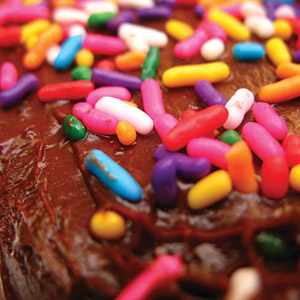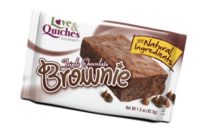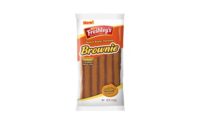Let’s take a look at how we can transform a basic brownie into a value-added product through the use of key functional ingredients and eye-catching inclusions.
 Since we tend to “eat” with our eyes first, visual appeal is a huge determinant for whether consumers deem a baked good desirable and ultimately purchase it. Colorful sprinkles and decorettes, polished sugar, nonpareils, and coconut crunch blends are a fun way to add charm, perhaps a theme or a textural twist to the standard soft brownie. A smooth bed of ganache or coating drizzled beneath these decorative touches serves as an adhesive and adds a distinct visual and textural layer that’s different from the baked base.
Since we tend to “eat” with our eyes first, visual appeal is a huge determinant for whether consumers deem a baked good desirable and ultimately purchase it. Colorful sprinkles and decorettes, polished sugar, nonpareils, and coconut crunch blends are a fun way to add charm, perhaps a theme or a textural twist to the standard soft brownie. A smooth bed of ganache or coating drizzled beneath these decorative touches serves as an adhesive and adds a distinct visual and textural layer that’s different from the baked base.
Bake-stable nuggets and slightly smaller bits added to the brownie batter can provide a contrasting firm texture and an opportunity to present a complementary flavor. Cinnamon, honey, natural fruit and marshmallow are just a few possibilities. Praline nuts and toffees offer an indulgent crunch. Pure chocolate chips, chunks and flakes in various sizes add gourmet flair, while compound or peanut butter versions can achieve the same look at more cost-effective price points.
To further round out the brownie flavor profile, consider a multitude of bake- and freeze/thaw-stable, natural, and natural and artificial flavors to incorporate in the batter and icing components. For example, adding a complementary dry cocoa flavor to a brownie blend or a cooling, liquid peppermint flavor to an icing drizzle accentuates the product theme and enhances the eating experience.
Emulsifiers are highly functional at low levels and serve as a processing aid and texturant. Because brownie batter is generally quite viscous, large molecular weight emulsifiers that contain polymerized glycerol and a polymerized fatty acid provide improved batter flow and stability by reducing the lipid-water interfacial tension. To extend the fresh, moist shelf life of a brownie, applying a self-hydrating powdered monoglyceride is ideal.
While most people don’t consider a brownie a healthy diet staple, ingredient technologies are available to reduce consumer health and wellness concerns about these delectable treats. Natural sweetness modulators, for instance, can increase the detected sweetness level via FEMA GRAS ingredients interacting with tongue taste receptors to manipulate the overall taste perception and flavor profile. With the right ingredient choice, bakers can achieve up to a 35 percent sugar reduction with no metallic flavors or off notes. Both liquid and powder forms are available, depending on processing requirements. Many of these “better brownie” ingredients are formulated these days without the use of partially hydrogenated oils. Therefore, to some degree, you can have your cake—or in this case, your brownie—and eat it, too!
Elyse Buckley recently graduated from Kansas State University, Manhattan, and is now a cereal research and development technologists at Kerry Ingredients and Flavors.





